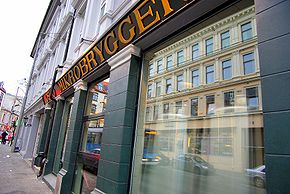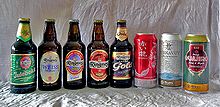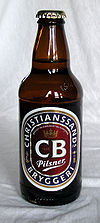- Beer in Norway
-
Beer in Norway has a long history, going back at least 1000 years. Until around 200 years ago no farm was complete without a brewhouse. From the early 20th century brewing was industrialized and home brewing outlawed. Since then, significant consolidation in the brewing sector has reduced the number of major breweries to just a handful. With the exception of the malty juleøl (Christmas beer), most beer styles brewed in Norway today trace their ancestry to central Europe.
Contents
Market
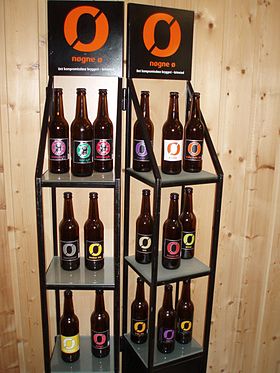 Beers from Nøgne Ø Brewery
Beers from Nøgne Ø Brewery
Currently, the Norwegian beer market is dominated by two large brewers: The giant Carlsberg-Ringnes based in Oslo and Copenhagen, Denmark, and the smaller Hansa-Borg, based in Bergen and Sarpsborg. Each produce beer branded in a variety of traditional Norwegian beer brands, as well as foreign brands bottled on licence. This system is a result of the large-scale consolidation of Norwegian breweries that has taken place over the last 50 years.
Craft brewing has a long history in Norway, harking back to the days when no farm was complete without a brewhouse. Many structures found at old properties include a designated "bryggehus": a separate building where beer was produced. Home brewing in Norway is common, albeit understated (due to its association with home distilling, which is illegal) pastime. Examples can be found in Oslo at Oslo Mikrobryggeri, Scandinavia's first microbrewery and brewpub, and Nøgne Ø in Grimstad.
As with most countries in Europe and America, the most popular style of beer in Norway is pilsner-style pale lager. According to the Norwegian brewers' association, almost 92% of beer brewed in Norway is pale lager.[1] In places[where?], this is the only style of beer to be had, except at Christmas time, when Christmas beers become available. These are dark malt beers traditionally brewed for the holiday season.
Due to government restrictions, beers above 4.75% abv are only available from licensed premises or from the state-run Vinmonopolet ("wine monopoly") liquor stores. This has resulted in some foreign breweries decreasing the alcohol content in their beer in order to make them legal for supermarket retail. In addition, in some municipalities alcohol sale is further restricted, with beer only being available through licensed retailers. This practice is mostly restricted to northern and western municipalities.
Norway has limited availability of beers on tap in pubs and nightclubs. This is due to the custom of each pub signing a contract with one brewery, limiting them to providing draught beer from that brewery. In exchange, the brewery will provide the bar with all the systems required for pulling beer, including tanks, taps, and glasses. In place of the tap selection, bars often carry a number of bottled beers. However, these usually carry a much higher price tag.
Styles
Styles of beer that are typical of Norwegian brewing traditions are:
Pilsner - the pale lager style which originated in the Czech city of Plzeň. This is the dominant beer type with almost 92% of the market share. The weaker (below 4.75% abv.) types are the most common, but most breweries also brew stronger varieties (similar to the Bavarian Spezial beer style) for sale through the Vinmonopol.
Bayer - a dark lager with roots in Bavaria (Bayern). The Norwegian version is often slightly sweeter than German dark lagers. Once rivaling pilsner in popularity, its market share has dropped from 20% in 1950 to 0.2% in 2004. Being the most popular industrial-brewed beer before the Second World War, it lost its popularity due to the occupation.
Juleøl - a dark, malted beer exclusively available at Christmas time. Traditionally this was a strong ale which was brewed at home. In modern times each brewery produces their own variety of Christmas beer, mostly a lager. Most breweries brew both weaker varieties (for sale in supermarkets) and more traditional, stronger varieties.
Bokkøl - a strong, dark style of lager, typically 6-7% ABV, with a sweet, complex flavor. It originates from Germany, where it is known as Bockbier.
Legislation
In Norway, beer is classified into four categories by ABV (alcohol by volume), labeled from A to D. The class both determine the tax level, age restrictions, where, and when it can be sold.
- Class A beer has an ABV of less than 0.7%, and is for all intents and purposes alcohol-free beer. It is not taxed more than general foodstuffs, and can be sold anywhere, any time, and be bought by anyone.
- Class B beer has an ABV between 0.7% and 2.75%, and is considered "lettøl" (light beer). It is lightly taxed, and can be sold anywhere, anytime, and be bought by anyone.
- Class C beer has an ABV between 2.75% and 3.75%. This category is not in common use.
- Class D beer has an ABV between 3.75% and 4.75%, and is considered standard strength. Taxation is significant, age limit is 18 years, and sales are subject to local regulation. In most parts of Norway, class D beer can be purchased from common supermarkets, but only before 20:00 on weekdays and 18:00 on Saturdays. In some parts of Norway it can only be purchased through licensed beer stores.
- Beer over 4,75% is considered sterkøl (strong beer) and is only sold through the government-controlled liquor store chain Vinmonopolet. It is taxed according to ABV level as with wines and spirits, and carries an 18 year age limit.
Common Brands
- Ringnes is originally from Oslo, and is brewed by Ringnes Bryggeri in Oslo. It is Norway's most sold beer brand. It is owned by the Danish brewery Carlsberg.
- Hansa is originally from Bergen, and is brewed by Hansa Brewery in Bergen, owned by Hansa Borg Bryggerier It is Norway's second largest beer brand.
- Aass is originally from Drammen, and is brewed by Aass Bryggeri in Drammen.
- Mack is originally from Tromsø, and is brewed by Macks Ølbryggeri in Tromsø. Macks Ølbryggeri is the world's northernmost brewery.
- CB is originally from Kristiansand, and is brewed by Christianssands Bryggeri (CB) in Kristiansand. CB is owned by Hansa-Borg Bryggerier.
- Borg is originally from Sarpsborg, and is brewed by Borg Bryggerier, that belongs to Hansa-Borg Bryggerier in Sarpsborg.
- E. C. Dahls is originally from Trondheim, and is brewed by Ringnes E. C. Dahls Bryggeri in Trondheim. E. C. Dahls is owned by Ringnes Bryggeri.
- Tou was originally from Stavanger. It is brewed by Ringnes Bryggeri in Oslo.
- Frydenlund is originally from Oslo. It is brewed by Ringnes Bryggeri in Oslo.
- Lundetangen is originally from Skien. It is brewed by Aass Bryggeri in Drammen.
- Grans is originally from Sandefjord. It is brewed by Grans Bryggeri in Sandefjord.
- Arendals is originally from Arendal. It is brewed by Arendals Bryggeri in Arendal.
- Nøgne Ø is originally from Grimstad, and is brewed by Nøgne Ø Brewery in Grimstad.
References
External links
- NORØL (Norske Ølvenners Landsforbund - Federation of Norwegian Beer Consumers) is a consumer organisation which campaigns to support traditional styles such as Bokkøl and Bayerøl.
- Norwegian Breweries
Beers of the world Africa 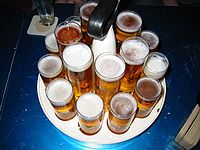
Asia Europe Americas Oceania Beer and breweries by region · List of countries by beer consumption per capita · Alcohol belts of EuropeCategories:- Beer and breweries in Norway
- Economy of Norway
Wikimedia Foundation. 2010.

